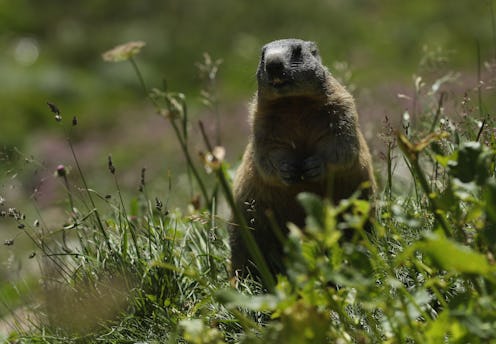
Well, it’s Feb. 2, so it’s time to ask that most pressing of questions: Did the groundhog see his shadow in 2017? Can we expect an early spring this year, or should resign ourselves to a longer winter? The news is out, and it's official: Punxsutawney Phil saw his shadow on Groundhog Day. That means we're allegedly in for six more weeks of cold weather, because... well, of course we are. It's been that kind of year so far, hasn't it?
According to the Washington Post, Phil emerged from his burrow in Punxsutawney, Pa. in the early morning of Feb. 2, making his prediction at around 7:25 a.m. Apparently scattered snow showers were in the area and the temperature was below freezing — about 25 degrees — so in some respects, it's perhaps unsurprising that the groundhog predicted more cold weather ahead; however, the Post also points out that the weather in January had quite a few spring-like days during it, which means it's always possible Phil will be wrong. He's been wrong before, in fact — according to AccuWeather, his accuracy is only about 80 percent.
Phil (or, perhaps more accurately, a succession of groundhogs named Phil) has been making annual predictions about the weather since 1887. Groundhog Day is rooted in the ancient Christian tradition of Candlemas, when, according to History.com, "clergy would bless and distribute candles needed for winter," with the candles representing the length and level of coldness of the season. A song associated with the holiday includes the lines:
If Candlemas be fair and bright,
Come, Winter, have another flight;
If Candlemas brings clouds and rain,
Go Winter, and come not again.
You can see how something about seeing a shadow versus not seeing one might in turn become connected with the day, right? If it's sunny out, shadows will be visible; if it's cloudy, though, they won't.
Here's your obligatory Groundhog Day GIF:
It's believed that celebrants in Germany added the whole animal element to the day, although it wasn't always a groundhog: It's been, at various points, a badger, a bear, or a hedgehog. Once German settlers arrived in Pennsylvania, they adapted the animal based on what was actually living in the wild in their new location: Groundhogs.
Although we're missing the data for some years, we do know that Phil has seen his shadow far often than not: According to the National Centers for Environmental Information, between 1887 and 2016, he saw his shadow 102 times and didn't see it a mere 18. Adding 2017's result to the mix, we have 103 shadow years. However, the NCEI also notes that, if you take a look at the actual temperatures for all of those years, it becomes clear that the groundhog as "no predictive skill" — or at least, not for the more recent years on the list. In fact, since 1993, the U.S. national temperature during the months of February and March has been above average rather a lot: 12 times in February and 15 times in March. It's only been below normal six times in February and twice in March. The other times — six for February and seven for March — it's been about average.
All of this is to say: Take the whole thing with a grain of salt. In fact, ABC News reports that Phil's prediction is actually decided ahead of time by his handlers. It's fun, sure; just don't put too much stock in the fate of the universe as dictated by a small, furry creature.
Also, groundhogs are marmots, not hogs. You might also know them by another name: Woodchucks. Is anyone else just a teeny bit curious about how much wood Phil could chuck if woodchucks could chuck wood?
No? Just me? Never mind, then. Carry on.